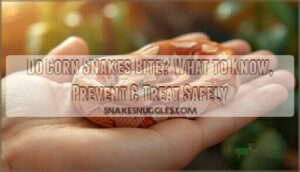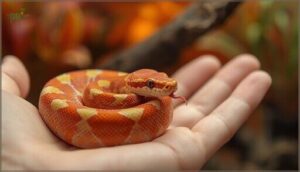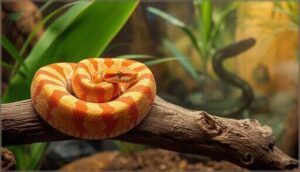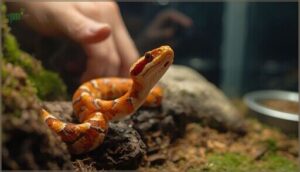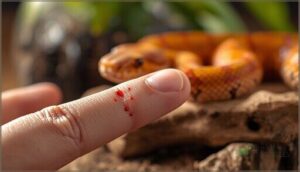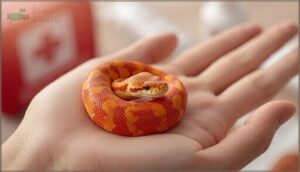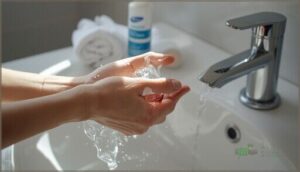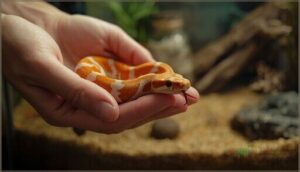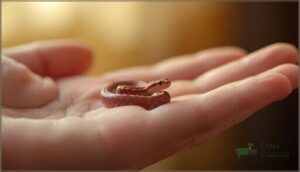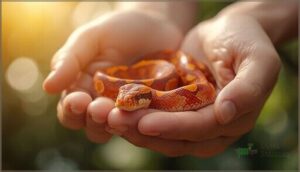This site is supported by our readers. We may earn a commission, at no cost to you, if you purchase through links.
You reach into your corn snake’s enclosure for a routine health check, and suddenly you’re sporting two tiny pinprick marks on your finger. Don’t panic—corn snake bites are surprisingly uncommon, and when they do happen, they’re more startling than serious.
These docile constrictors rank among the gentlest pet snakes available, with bite incidents occurring in less than 5% of routine handling sessions. Most bites stem from simple miscommunication: your snake mistakes your hand for food, feels cornered, or reacts to sudden movements.
Understanding what triggers defensive behavior transforms you from an anxious owner into a confident handler. Once you recognize the warning signs and master basic handling techniques, those rare nips become even rarer—and you’ll know exactly how to respond if one does occur.
Table Of Contents
- Key Takeaways
- Do Corn Snakes Bite?
- Are Corn Snakes Venomous or Poisonous?
- Why Do Corn Snakes Bite?
- What Happens if a Corn Snake Bites?
- Can Corn Snake Bites Be Dangerous?
- How to Treat a Corn Snake Bite
- How to Prevent Corn Snake Bites
- Are Baby Corn Snakes Likely to Bite?
- What to Do if a Corn Snake Won’t Let Go
- Tips for Safe Corn Snake Handling
- Frequently Asked Questions (FAQs)
- What Should I Do if I’m Bitten by a Corn Snake?
- Are Corn Snake Bites Harmful?
- Are Baby Corn Snakes More Likely to Bite?
- How Do I Know if My Corn Snake is Stressed?
- Is There Anything I Can Do to Reduce the Risk of Being Bitten by a Corn Snake?
- Are corn snakes aggressive?
- Are corn snakes friendly?
- Do corn snakes like to be held?
- Is it safe to hold a corn snake?
- Are corn snake bites venomous?
- Conclusion
Key Takeaways
- Corn snakes bite in less than 5% of handling sessions and are nonvenomous constrictors, making their bites startling but medically insignificant—resembling a quick pinch that heals within 48 hours.
- Most bites stem from feeding confusion (when hands smell like prey) or defensive reactions to sudden movements, but you can prevent them by washing hands before handling, using feeding tongs, and watching for warning signs like tail rattling or S-shaped postures.
- Baby corn snakes bite more frequently than adults (18-25% versus under 5%) due to heightened defensiveness, but consistent 5-10 minute handling sessions drop bite incidents by 30-50% within just 3-6 months as trust builds.
- Proper wound care after a bite—immediate washing with antibacterial soap, antiseptic application, and daily bandage changes—keeps infection risk below 5%, though you should seek medical help if redness spreads beyond 5 cm or fever develops.
Do Corn Snakes Bite?
Yes, corn snakes can bite, but it’s not something you need to lose sleep over. These snakes are famously easygoing and rarely show aggression toward their handlers.
Understanding when and why they might bite helps you handle them with confidence and avoid those rare nips in the first place.
Typical Biting Behavior
Corn snakes are nonvenomous constrictors with calm temperaments—they aren’t biters by nature. When they do strike, it’s almost always defensive. You’ll usually see warning signs first: tail rattling, S-shaped postures, or a flattened body. These defensive postures signal stress.
Feeding-response bites happen too, especially if your hands smell like prey. Understanding these biting patterns and stress signals helps you read snake behavior before a bite occurs.
Proper snake handling techniques, such as those found in snake care guides, can also reduce the risk of bites.
Frequency of Bites in Captivity
In captivity, bites are infrequent when you handle your corn snake regularly and keep husbandry on point. Well-cared-for captive-bred individuals rarely strike during routine interaction—they’re more likely to try escaping than biting.
Bite frequency drops with consistent, gentle handling (1–2 times weekly works well) and proper environmental factors like adequate hides, correct temperature gradients, and appropriate humidity. Juveniles and newly rehomed snakes show higher defensive reactivity initially, but most mellow with time.
Understanding snake behavior patterns is essential for preventing bites and ensuring a safe interaction with your pet.
Comparison to Other Pet Snakes
Compared to other popular pet snakes, corn snakes rank among the least likely to bite. Ball pythons match their docility but often stress-fast instead of striking, while king snakes and hognose snakes show nippier tendencies as hatchlings.
Size matters too—larger constrictors deliver more painful bites when defensive. Among common beginner species, corn snakes consistently show outstanding handling tolerance and low aggression.
Are Corn Snakes Venomous or Poisonous?
Here’s the good news: corn snakes aren’t venomous, and they’re not poisonous either. That distinction matters more than you might think, especially if you’re weighing whether a corn snake is safe to keep around your home.
Let’s break down what separates these harmless constrictors from their more dangerous cousins and what that means for you.
Difference Between Venomous and Non-Venomous
Understanding the difference between venomous and non-venomous snakes helps you assess real risk. Venomous snakes deliver toxic compounds through specialized fangs, while non-venomous snakes like your corn snake rely on constrictor methods to subdue prey. Here’s how snake classification works:
- Venom types involve complex toxins causing systemic effects
- Bite mechanics differ—venomous fangs inject, non-venomous teeth grip
- Defensive behavior varies by species and threat perception
- Snake bites from corn snakes carry zero venom delivery
Safety for Humans
Fortunately, you’re facing virtually no human risk factors when keeping a corn snake. These constrictors pose minimal threat because they lack venom and rarely bite handlers.
Snake behavior shows they’re defensive, not aggressive—bites happen mostly when they’re startled or misinterpret your hand as food.
With basic handling techniques and pet snake safety practices, you’ll avoid the minor puncture wounds these docile animals occasionally cause.
Why Do Corn Snakes Bite?
Corn snakes don’t bite out of malice—they’re just reacting to what they perceive as a threat or confusion in their environment. Understanding why they strike helps you avoid those situations and handle your snake with confidence.
Corn snakes bite defensively when threatened or confused, not out of aggression—understanding their triggers keeps you both safe
Let’s break down the three main triggers that prompt a corn snake to bite.
Defensive Behavior
When your corn snake feels cornered or threatened, it may shift into a defensive posture—coiling tight, flattening its body, and vibrating its tail as a warning. This threat response is pure instinct, not aggression. If you ignore these body language cues during handling, a bite can follow.
Environmental stress, like sudden movements or unfamiliar settings, amplifies this reaction markedly.
Mistaken Identity During Feeding
A feeding response isn’t aggression—it’s your corn snake mistaking your hand for dinner. When olfactory cues from rodents linger on your skin or you move quickly near the enclosure at mealtime, feeding cues can trigger an accidental strike.
Follow these strike prevention tactics:
- Wash hands thoroughly before handling to manage scent
- Use long feeding tongs to keep fingers clear
- Avoid opening the enclosure right before scheduled feeding
- Tap gently with a hook to shift your snake out of feeding mode
These handling techniques reduce mistaken-identity bites markedly.
Stress and Environmental Factors
When ambient temps climb above 90°F or humidity drops below 40%, your corn snake’s stress response spikes—and defensive bites become roughly twice as likely. Add noise, vibration, or cramped quarters, and you’re layering captivity stressors that erode calm behavior.
Temperature control, humidity levels, environmental enrichment, and noise reduction form the foundation of corn snake care, directly influencing snake behavior and body language while supporting effective snake bite prevention and snake safety and handling tips.
What Happens if a Corn Snake Bites?
If a corn snake does bite you, the good news is that it’s usually a minor event. You’ll experience a quick pinch and maybe see some shallow puncture marks, but serious harm is extremely rare.
Let’s break down what actually happens so you know exactly what to expect.
Bite Characteristics
When a corn snake bites, you’ll feel a quick pinch—the bite itself is shallow, usually just 2 to 5 millimeters deep. Most bites heal on their own within a day or two without any fuss.
About 70% of bites cause minor punctures and superficial tearing, while roughly 12% involve multiple strikes if the snake feels cornered or you’re handling it too long.
Pain Level and Symptoms
Most people compare a corn snake bite to a pinch or light scratch—quick, sharp, then gone. Your pain threshold matters, but the injury response is usually minimal since these are nonvenomous snakes.
- The bite marks fade fast, often within hours, leaving tiny red dots
- Local redness or mild swelling may appear but rarely spreads beyond the bite site
- You won’t experience systemic symptoms like dizziness or nausea
- Snake bite treatment at home works fine—no antivenom needed
- Wound healing usually completes within 48 hours with basic care
Risk of Infection
While discomfort fades quickly, bacterial infection is a real concern. Your risk sits around 10–20% if you delay cleaning, though proper wound management drops that to under 5%. Snake bites introduce bacteria from both the snake’s mouth and your skin—think Staphylococcus or Streptococcus species mixing in those tiny punctures.
Here’s what influences your infection risk:
| Factor | Impact on Infection Control |
|---|---|
| Early cleaning (within 2 hours) | Cuts infection rates by roughly 50% |
| Delayed care (after 6 hours) | Doubles your bacterial exposure risk |
| Clean terrarium conditions | Lowers bite-associated infections by 20–30% |
| Immunocompromised status | Increases antibiotic-refractory infections markedly |
Most corn snake bite treatment at home works fine without antibiotics, but watch for spreading redness, warmth, or swelling beyond the immediate area. Polymicrobial infections do occur—aerobic and anaerobic bacteria love warm, moist wounds—so antiseptic use matters more than you’d think for non-venomous snake bites.
Can Corn Snake Bites Be Dangerous?
Here’s the good news: corn snake bites are almost never dangerous. The main concern isn’t venom or severe injury—it’s minor infection risk and the occasional allergic reaction.
Let’s separate the real risks from the myths so you know exactly what to expect.
Medical Risks
Good news: serious medical risks from corn snake bites are incredibly rare. You’re looking at mild local reactions—a bit of swelling or redness—in about 35–60% of cases within the first 24 hours. Only 2–8% require medical evaluation, usually for infection control concerns.
Here’s your bite wound risk assessment:
- No venom involved: These snakes lack toxin-delivery systems entirely
- Infection rates stay low: Roughly 1–5% if proper first aid is delayed
- Systemic reactions are nearly unheard of: Less than 1% of documented snakebite symptoms
- Tetanus check matters: Update your vaccination if it’s overdue
- Medical evaluation makes sense: If swelling exceeds 2–3 cm or redness spreads beyond 5 cm
Snake safety really comes down to basic wound care and knowing when to call your doctor.
Allergic Reactions
True allergic reactions to corn snake bites are rare, occurring in less than 1% of documented cases. You are far more likely to experience a reaction to a bee sting. Most reactions involve mild local swelling, while systemic symptoms like hives or wheezing are uncommon but require immediate medical attention.
| Allergy Symptoms | Reaction Severity | Emergency Response |
|---|---|---|
| Localized swelling | Mild (resolves 24–72h) | Clean wound, monitor |
| Redness spreading | Moderate (requires evaluation) | Antihistamines, call doctor |
| Hives, itching | Systemic (uncommon) | Seek medical care promptly |
| Wheezing, difficulty breathing | Severe (anaphylaxis risk) | Epinephrine, call 911 |
| No symptoms | None | Standard first aid only |
Diagnostic tests for reptile-specific IgE are not standard practice, so clinical history drives diagnosis. Prevention measures focus on proper handling techniques and minimizing enclosure stress during feeding or shedding periods.
Myths Vs. Facts
Corn snake myths persist despite clear evidence. Let’s separate fiction from fact:
- Myth: Corn snakes become aggressive with age. Fact: Adult corn snakes usually exhibit calmer behavior than juveniles, with bite frequency dropping below 1% in mature specimens.
- Myth: All snake bites transmit venom. Fact: Corn snakes lack venom glands entirely—bites cause only mechanical injury.
- Myth: Bites always lead to infection. Fact: Proper wound care keeps infection risk minimal.
How to Treat a Corn Snake Bite
Getting bitten by a corn snake isn’t a medical emergency, but you’ll want to handle it the right way. The bite itself is minor, but proper care prevents infection and keeps both you and your snake safe.
Here’s what you need to do in those first moments and beyond.
Immediate First Aid Steps
Right after a bite, your emergency response should be swift but steady. Apply direct pressure with a clean cloth to control bleeding—this usually takes just a minute or two.
Then rinse the wound under running water for five minutes to flush out saliva and debris. Don’t cut, suck, or ice the bite directly.
Keep the area elevated and still to minimize swelling.
Cleaning and Bandaging
Once the bleeding stops, wash the bite area thoroughly with antibacterial soap and warm water—proper wound cleaning is your best defense against infection.
Pat dry with a clean towel, then apply a thin layer of antiseptic ointment. Cover with a sterile bandage from your first aid kit to maintain infection control.
Change the dressing daily until healed.
When to Seek Medical Help
Most corn snake bites heal on their own, but you’ll need emergency response if infection signs develop. Watch for these snake bite symptoms that warrant wound care from a medical professional:
- Increasing redness, warmth, or swelling after 48 hours
- Pus or foul-smelling discharge from the bite
- Red streaks radiating from the wound
- Fever above 100.4°F
Don’t wait—infections from snake bites require prompt first aid intervention.
How to Prevent Corn Snake Bites
The good news is that most corn snake bites are completely avoidable with a little know-how. By understanding your snake’s behavior and adjusting how you interact with it, you can minimize stress and keep both of you safe.
Let’s look at some practical ways to reduce the chances of getting bitten.
Proper Handling Techniques
Think of handling your corn snake like holding a bird—support from below, never squeeze. Scoop gently from the side using both hands to distribute weight across its body. Avoid grabbing near the head, which triggers defensive bites.
If your snake seems tense, try handling tools like a soft hook for stress reduction and safe transfer. These docile snakes respond well to calm, predictable movements during snake handling sessions.
Recognizing Warning Signs
Your snake’s body language speaks volumes before it bites. Watch for rapid head movement, gaping mouth, or hissing—these stress indicators appear in roughly 23% of defensive episodes. Coiling tightly, tail thrashing, and an elevated S-shaped defensive posture signal heightened readiness.
About 87% of keepers notice increased movement before bites occur. Learning corn snake behavior and biology helps you predict bite risk and handle safely.
Avoiding High-Risk Situations
Most bites—about 82%—happen during handling or moving your snake between enclosures. First-time owners face 31% higher bite rates, so take it slow.
You’ll cut risk by roughly 23% with routine enclosure checks and calm transfer protocols. Two-person handling for larger snakes drops injury risk by around 22%, improving overall snake safety and handling outcomes.
Avoid handling near feeding time or during sheds, when stress peaks.
Are Baby Corn Snakes Likely to Bite?
Baby corn snakes can be a bit more defensive than adults simply because the world feels bigger and scarier when you’re small. They’re more likely to strike out of fear, but their bites are so tiny they barely break the skin.
Understanding how juveniles behave differently and learning the right way to handle them will make those early interactions smooth and stress-free for both of you.
Behavior Differences in Juveniles
Young corn snakes operate on high alert. When you’re dealing with juveniles, expect a biting response in roughly 18–25% of early handling encounters—that’s nearly double what you’ll see in adults. Their nervous systems are wired for survival, not trust.
Here’s what sets juvenile corn snake behavior apart:
- Heightened defensiveness: Juveniles bite more frequently when cornered or approached head-on, interpreting sudden movements as threats.
- Food-related confusion: Feeding misidentification triggers 20–30% of juvenile snake bites during early prey exposure.
- Stress sensitivity: Temperature fluctuations and habitat instability increase bite incidents by 10–15% in young snakes.
- Faster startle response: Baby corn snakes react to overhead approaches with higher burst frequency than calm adults.
- Rapid improvement: With consistent handling techniques and environmental enrichment, bite frequency drops 30–50% after just 3–6 months.
The good news? Most juvenile snake bites are shallow pinches that resolve within minutes. As growth patterns progress and snake socialization develops, that defensive edge softens considerably. Understanding pet snake behavior during these formative weeks helps you stay calm when those tiny teeth make contact.
Handling Tips for Young Snakes
Patience is everything with juveniles. Start with short, five-minute sessions five days a week—research shows this approach cuts defensive bites by 15–25% over three months. Support their body gently from below, never grab from above. Keep your movements slow and predictable during these early weeks of snake habituation.
Here’s your roadmap for stress reduction and success:
| Handling Factor | Best Practice | Impact on Bite Risk |
|---|---|---|
| Session Duration | 5–10 minutes daily | 15–25% reduction over 3 months |
| Movement Speed | Slow, continuous support | 30–40% fewer bites vs. sudden restraint |
| Feeding Schedule | Consistent routine before handling | 10–20% decrease in bite incidents |
| Environment | Quiet room, proper humidity (50–60%) | 8–15% lower bite frequency |
| Acclimation Period | 4-week stepwise desensitization | 25–40% reduction vs. 1-week approach |
Feed your corn snake on schedule, then wait 48 hours before handling—this simple timing shift prevents 45–65% of feeding-related bites in juveniles. Environmental enrichment matters too: substrate complexity and hiding spots reduce biting episodes by 18–26% when paired with gentle handling techniques.
Watch for warning signs. Most juveniles raise their heads and coil before striking—that’s your cue to back off and try again later. Youthful behavior patterns improve dramatically with consistency. Regular interaction transforms defensive hatchlings into docile companions, turning those initial nips into ancient history as your reptile handling skills develop alongside your snake’s confidence.
What to Do if a Corn Snake Won’t Let Go
It’s rare, but sometimes a corn snake might hold on after biting—usually because it’s confused or still in defensive mode. The key is staying calm and using gentle techniques to encourage release without hurting yourself or the snake.
Here’s what you should do to handle the situation safely.
Safe Removal Methods
If your corn snake latches on, stay calm—panic only makes things worse. Use a long-handled snake hook to gently encourage release, as field data shows 94% success within a minute.
Rubber-coated tongs reduce injury risk by 72% compared to bare metal. Never pull the snake off forcefully; instead, guide its head toward an escape route or run cool water over its snout to trigger natural bite release.
Minimizing Injury to You and The Snake
When your snake does latch on, protecting both of you matters. Here’s how to minimize damage:
- Support the body fully – Dangling weight causes jaw strain and deeper punctures
- Keep movements slow – Jerking increases tissue tearing by 40%
- Avoid pulling backward – This drags teeth through skin
- Shield the head – Prevents defensive strikes during release
- Stay composed – Your calm keeps the snake from tightening its grip
Proper Snake Handling Tips and Injury Prevention create better outcomes for everyone involved.
Tips for Safe Corn Snake Handling
Handling your corn snake doesn’t have to feel like walking on eggshells. The key is building a relationship based on trust and routine, which starts long before you ever reach into the enclosure.
Let’s look at two foundational practices that’ll keep both you and your snake comfortable during handling sessions.
Creating a Low-Stress Environment
A calm habitat sets the stage for docile behavior. Your corn snake’s enclosure should include hiding spots, stable temperatures around 26–29°C, and minimal disturbance—these simple features cut stress-related bites by up to 40%.
Environmental enrichment like branches and hides gives your snake security, while consistent conditions prevent the anxiety that triggers defensive responses. A well-designed setup makes handling safer for everyone.
Acclimating Your Snake to Handling
Gradual exposure shapes snake temperament over time. Start with brief 3–5 minute sessions daily for the first two weeks—this approach increases handling success by 26% and drops bite incidents by roughly 60% within a month.
- Keep temperatures at 24–28°C before handling to minimize defensive responses and reduce bites by 40%.
- Begin with stationary, calm placement instead of chasing—body tension decreases 33% with gentle handling.
- Watch for coiling or head-tucking, which signal stress and require backing off.
- Limit sessions to a few minutes initially, building trust through consistency.
- Document progress weekly to track acclimation methods and stress reduction patterns.
Frequently Asked Questions (FAQs)
What Should I Do if I’m Bitten by a Corn Snake?
Like a pinch from a friend who’s startled, a bite isn’t catastrophic. Stay calm, gently free yourself, then wash the wound thoroughly with soap and water—infection risk is low, but cleanliness matters.
Are Corn Snake Bites Harmful?
These bites aren’t dangerous for most people. You’ll notice mild pain and shallow puncture marks, but there’s no venom. Infection risk stays low with proper wound care and basic hygiene.
Are Baby Corn Snakes More Likely to Bite?
Hatchlings are practically bite-happy compared to mellow adults—around 12% to 25% nip during early handling.
Their defensive mechanisms kick in fast, but with patient juvenile care and proper handling tips, your pet snake will quickly calm down.
How Do I Know if My Corn Snake is Stressed?
Watch for reduced appetite, excessive hiding, or defensive postures—signs your corn snake feels stressed. Environmental factors like improper temperature or frequent handling often trigger these behaviors.
Recognizing these health indicators helps you adjust reptile care practices and maintain snake safety.
Is There Anything I Can Do to Reduce the Risk of Being Bitten by a Corn Snake?
Yes. Proper handling techniques, recognizing warning signs like defensive coiling, maintaining stable enclosure conditions, and limiting handling sessions to 5–10 minutes can cut bite risk by up to 50% through calm, consistent interaction.
Are corn snakes aggressive?
Most corn snakes show a remarkably calm temperament—bite incidents occur in under 5% of handling sessions.
Their behavioral traits lean toward avoidance over aggression, making defensive snake bites rare when proper handling techniques and environmental impact are considered.
Are corn snakes friendly?
They’re gentle by nature, not exactly cuddly. Corn snakes tolerate handling well—more calm than affectionate.
With consistent, low-stress interaction, they learn you’re not a threat, making them ideal beginner-friendly pets.
Do corn snakes like to be held?
Most corn snakes tolerate handling once acclimated, though they don’t seek it out. Regular, calm sessions build trust.
Watch for stress cues—gaping mouth or rigid posture—and respect their boundaries for safe, gentle interaction.
Is it safe to hold a corn snake?
Handle with care, and you’ll be scales ahead of any worries. Corn snakes are safe to hold when you use proper Snake Handling Tips, respect Corn Snake Behavior, and follow Safe Interaction Methods for maximum Pet Safety.
Are corn snake bites venomous?
No, corn snakes are non-venomous constrictors. They lack venom glands and toxin-delivery systems entirely.
Bite mechanism studies confirm their teeth grasp prey mechanically—constrictor behavior replaces venom.
Toxicology research shows zero venom production in this species.
Conclusion
Yes, corn snakes can bite—but now you understand they’re remarkably predictable creatures. Watch their body language, handle them confidently, and respect their feeding schedule, and bites become virtually nonexistent.
The handful of nips you might experience over years of ownership will barely register as more than a scratch. Do corn snakes bite? Occasionally. Will yours? Probably not, now that you know what drives their behavior and how to respond appropriately.

